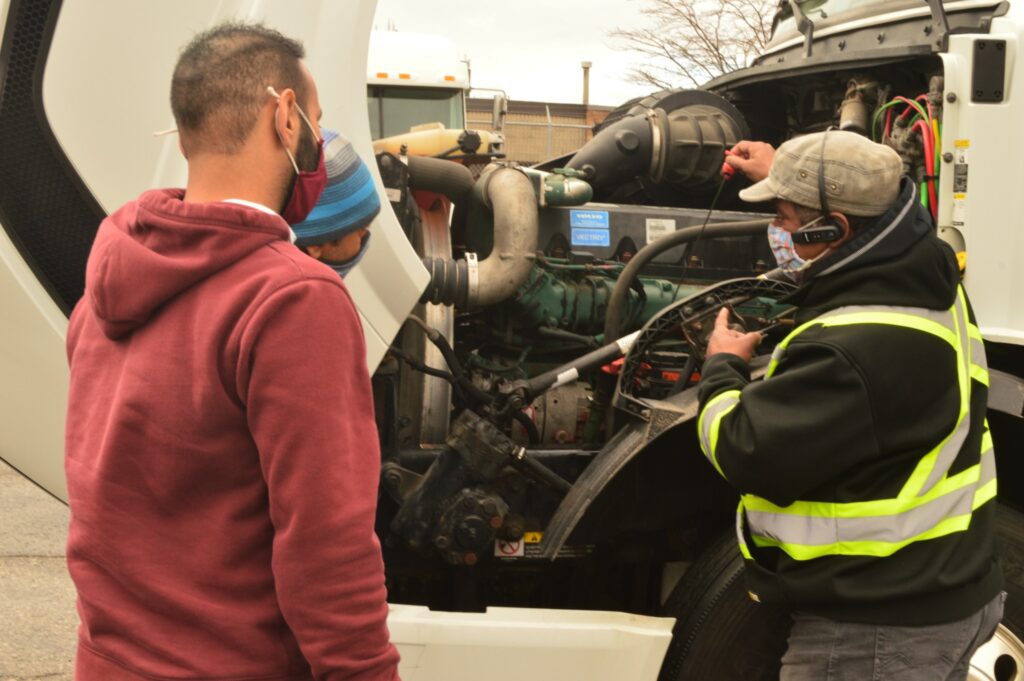The annual Roadcheck inspection will be held May 4-6 and commercial vehicle inspectors will be focusing on lighting issues and hours-of-service violations.
According to the Commercial Vehicle Safety Alliance (CVSA), one-fifth of the more than 50,000 commercial vehicle inspections conducted during the 2020 International Roadcheck event resulted in a vehicle being taken out of service because of safety violations.

An instructor explains the details of a pre-trip inspection to students at Trukademy, a truck driving school in Mississauga, Ont. (Photo: Leo Barros)
And of all violations found during the inspection event, close to 40% were tied to the vehicle’s brake system and/or brake adjustment. Other top violation categories included issues related to tires, lights, and cargo securement.
Trucker Holly Faso, who works in the Greater Toronto Area, has not heard about the safety blitz. When asked whether she would prepare differently for it, she replied, “It does not change anything for me, I do thorough pre-trip inspections every day.”
Roadcheck does not worry Daryn Rabb, health and safety manager, Musket Transport. “We inform our drivers about the blitz but not for extra preparation. Officials are inspecting for the standard things that you have to check as part of your circle check or hours-of-service on a regular basis anyways,” he says.
“We tell our drivers to be patient and plan the time an inspection could take into your trip, because you could be delayed,” Rabb adds.
Bendix Commercial Vehicle Systems wants to make it easier for fleets and owner-operators to prepare for inspections and to accomplish basic maintenance tasks by providing proactive advice on brake systems and wheels in time for this year’s event.
“A review of the findings from the 2020 International Roadcheck event shows that more than 7,200 vehicles and 2,300 drivers were removed from roadways due to a critical finding either related to the safety of the vehicle or of the driver,” said Fred Andersky, Bendix director – demos, sales and service training.
“And of these infractions, problems related to the brake system or to brake adjustment topped the list of violations considered critical enough to put a vehicle out of service. Those violations accounted for 38% of all out-of-service violations found. All told, CVSA’s data shows about 21% of the vehicles inspected were put out of service, and the brakes or brake adjustment were a common reason why.”
Andersky says, “Keep in mind that brakes are one of the foundations for driver safety and for optimal operation of vehicle on-board technologies. That’s why keeping vehicle brakes in good shape is critical in helping to maintain overall safety on the road, and why CVSA’s Roadcheck – along with a regular schedule of preventive maintenance – is so important.”
The Bendix official says, “However, many of the critical issues flagged during these inspections are maintenance-related, and many are issues that could have easily been prevented with regular, thorough maintenance procedures. Inspections may find that brakes need to be adjusted or that tires are improperly inflated, for example. Or they may highlight a driver or technical issue that could have been prevented through training.”
When asked how student drivers are trained for inspections, Jacques Naltais, lead instructor at Trukademy says they are schooled in pre-trip inspections from bumper to bumper. “Attention is paid to the brake test, using the mark and measure method and checking of headlights and marker lights is part of the daily inspection,” he adds.
Students at the truck driving school are also taught how to perform a post-trip inspection. They are trained to do on-trip inspections, getting down from the passenger side and doing a circle check. So, a complete light and tire inspection is performed each time they exit the vehicle.
“We make sure our students know the difference between minor and major defects. For example, if you have a flat tire it’s a major defect, if you have a slow leak it’s a minor one,” Naltais says.
Lights are part of a driver’s regular checks, Musket Transport’s Rabb says. They are tricky because bulbs do burn out. “We have no real concerns regarding the hours-of-service because all of our drivers are on ELDs,” he adds.
Rabb says officers are human and they pull over trucks that they feel might have a problem. What is reported in the news is this many trucks were inspected and this number of defects were found, he says. “What the public perceives is that this many trucks on the road have a problem. The real statistic is of all the trucks the inspectors thought might have a problem, only this many did.” Rabb says.
Driver Faso says the safety blitz is helpful, particularly regarding the hours of service. “Having a tired driver out on the road is very dangerous. You could kill innocent people,” she says.
“Having a tired driver out on the road is very dangerous.”Holly Faso, truck driver
Faso says lighting is important at night, people need to see the truck and the driver needs lights to drive, but it takes a back seat to the hours of service.
International Roadcheck, which was created in 1988, is the largest targeted commercial motor vehicle program in the world, with more than 1.4 million roadside inspections conducted over the history of the event. On average, nearly 15 trucks or buses are inspected every minute of the 72-hour period.
Inspectors in Canada, Mexico and the U.S. examine a wide range of vehicle- and driver-related processes and equipment, such as brake systems, steering mechanisms, tires, cargo securement, suspensions, and more to make sure they are compliant with regulations.
Inspectors are on the lookout for critical vehicle inspection item violations, as outlined in the North American Standard Out-of-Service Criteria. If these violations are found, then the vehicle will be put out of service and cannot be operated until the conditions are corrected.
Visit our site for more information on commercial vehicle safety.